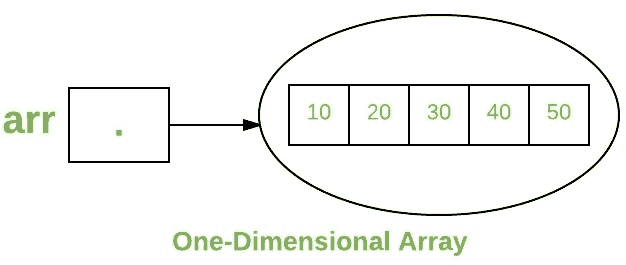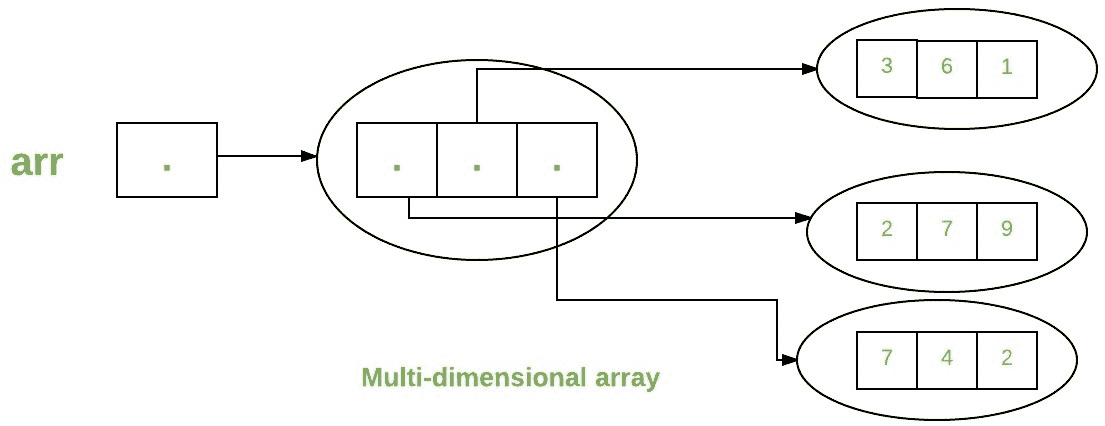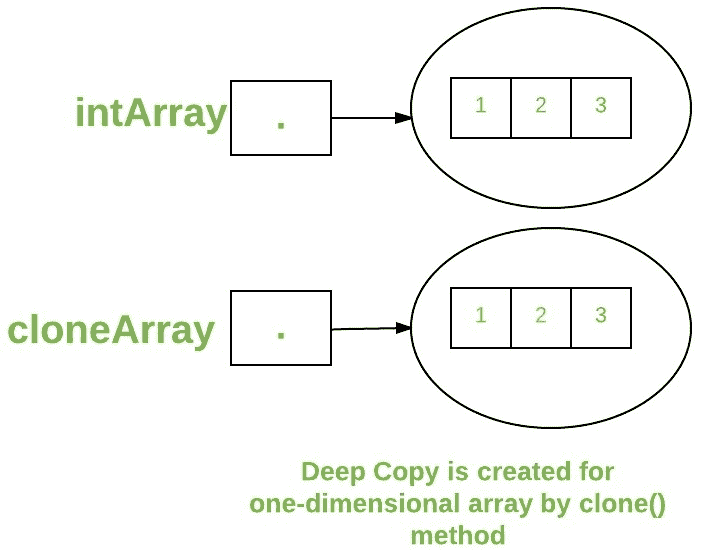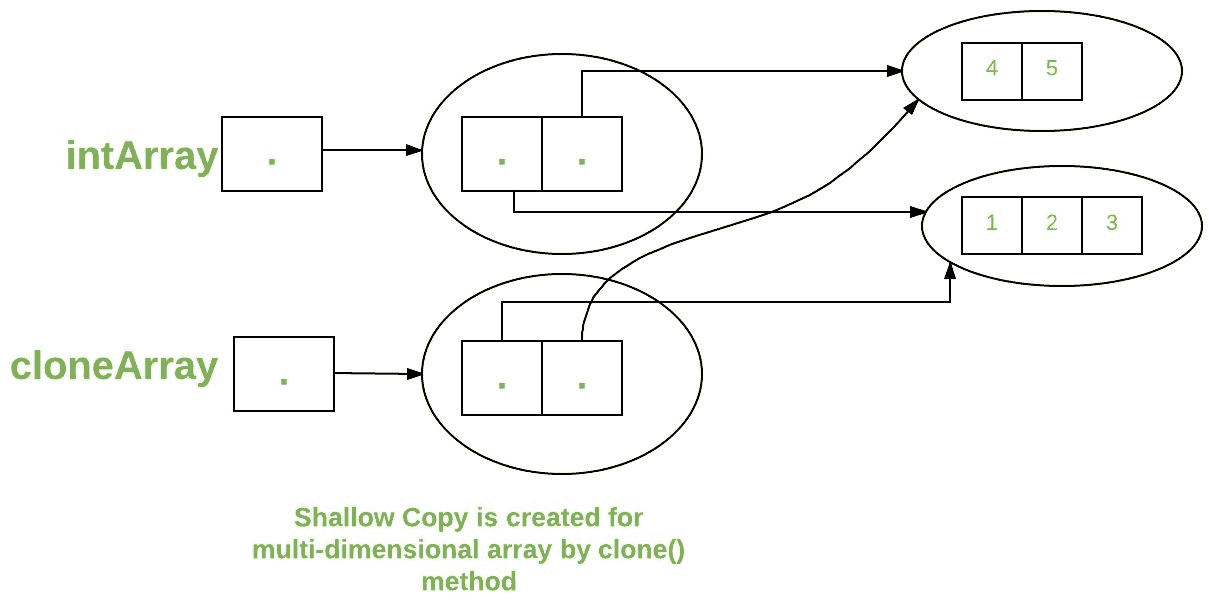# Java 中的數組
> 原文: [https://www.geeksforgeeks.org/arrays-in-java/](https://www.geeksforgeeks.org/arrays-in-java/)
數組是一組由通用名稱引用的相似類型的變量。Java 中的數組工作方式與 C/C++ 中的不同。 以下是有關 Java 數組的一些要點。
* 在 Java 中,所有數組都是動態分配的。(下面討論)
* 由于數組是 Java 中的對象,因此我們可以使用成員長度來找到它們的長度。 這與 C/C++ 不同,在 C/C++ 中,我們使用`sizeof`查找長度。
* 像其他變量一樣,也可以在數據類型之后使用`[]`聲明 Java 數組變量。
* 數組中的變量是有序的,每個變量的索引都從 0 開始。
* Java 數組也可以用作靜態字段,局部變量或方法參數。
* 數組的**大小**必須由`int`值指定,且不能長或短。
* 數組類型的直接超類是[對象](https://www.geeksforgeeks.org/object-class-in-java/)。
* 每種數組類型都實現接口 [Cloneable](https://www.geeksforgeeks.org/marker-interface-java/) 和 [java.io.Serializable](https://www.geeksforgeeks.org/serialization-in-java/) 。
數組可以包含類的基元(`int`,`char`等)以及對象的對象(或非基元)引用,具體取決于數組的定義。 對于基元數據類型,實際值存儲在連續的存儲位置中。 對于[類的對象](https://www.geeksforgeeks.org/g-fact-46/),實際對象存儲在堆段中。
[](https://media.geeksforgeeks.org/wp-content/uploads/Arrays1.png)
**創建,初始化和訪問數組**
**一維數組**:
一維數組聲明的一般形式是
```
type var-name[];
OR
type[] var-name;
```
數組聲明有兩個組成部分:類型和名稱。 *類型*聲明數組的元素類型。 元素類型確定組成數組的每個元素的數據類型。 像`int`類型的數組一樣,我們還可以創建其他原始數據類型的數組,例如`char`,`float`,`double`.. 等或用戶定義的數據類型(類的對象)。因此,數組的元素類型決定了哪種類型的 數組將保存的數據。
**例如**:
```
// both are valid declarations
int intArray[];
or int[] intArray;
byte byteArray[];
short shortsArray[];
boolean booleanArray[];
long longArray[];
float floatArray[];
double doubleArray[];
char charArray[];
// an array of references to objects of
// the class MyClass (a class created by
// user)
MyClass myClassArray[];
Object[] ao, // array of Object
Collection[] ca; // array of Collection
// of unknown type
```
盡管上述第一個聲明確定了`intArray`是一個數組變量的事實,但**實際上沒有數組**。 它只是告訴編譯器這個(`intArray`)變量將保存一個整數類型的數組。 要將`intArray`與實際的物理整數數組鏈接,必須使用新的**新**分配一個并將其分配給`intArray`。
**實例化 Java 中的數組**
聲明數組時,僅創建數組的引用。 要實際創建數組或為數組提供內存,您可以這樣創建一個數組: *new* 應用于一維數組的一般形式如下所示:
```
var-name = new type [size];
```
此處,*類型*指定要分配的數據類型,*大小*指定數組中元素的數量, *var-name* 是數組變量的名稱, 鏈接到數組。 也就是說,要使用*新的*分配數組,**必須指定要分配的元素的類型和數量。**
**示例**:
```
int intArray[]; //declaring array
intArray = new int[20]; // allocating memory to array
```
要么
```
int[] intArray = new int[20]; // combining both statements in one
```
**注意**:
1. 由*新*分配的數組中的元素將自動初始化為**零**(對于數字類型),**假**(對于布爾值)或 **null** (用于參考類型)。請參考 [Java](https://www.geeksforgeeks.org/default-array-values-in-java/) 中的默認數組值
2. 獲取數組是一個兩步過程。 首先,必須聲明所需數組類型的變量。 其次,您必須使用`new`分配用于保存數組的內存,并將其分配給數組變量。 因此,Java 中的**所有數組都是動態分配的**。
**數組文字**
在已知數組大小和數組變量的情況下,可以使用數組文字。
```
int[] intArray = new int[]{ 1,2,3,4,5,6,7,8,9,10 };
// Declaring array literal
```
* 該數組的長度決定了所創建數組的長度。
* 無需在最新版本的 Java 中編寫新的`int[]`部分
**使用`for`循環**訪問 Java 數組元素
數組中的每個元素均通過其索引訪問。 索引以 0 開頭,以(總數組大小`- 1`) 結束。 可以使用 Java `for`循環訪問數組的所有元素。
```
// accessing the elements of the specified array
for (int i = 0; i < arr.length; i++)
System.out.println("Element at index " + i +
" : "+ arr[i]);
```
**實現**:
```
// Java program to illustrate creating an array
// of integers,? puts some values in the array,
// and prints each value to standard output.
class GFG?
{
????public static void main (String[] args)?
????{?????????
??????// declares an Array of integers.
??????int[] arr;
??????// allocating memory for 5 integers.
??????arr = new int[5];
??????// initialize the first elements of the array
??????arr[0] = 10;
??????// initialize the second elements of the array
??????arr[1] = 20;
??????//so on...
??????arr[2] = 30;
??????arr[3] = 40;
??????arr[4] = 50;
??????// accessing the elements of the specified array
??????for (int i = 0; i < arr.length; i++)
?????????System.out.println("Element at index " + i +?
??????????????????????????????????????" : "+ arr[i]);??????????
????}
}
```
輸出:
```
Element at index 0 : 10
Element at index 1 : 20
Element at index 2 : 30
Element at index 3 : 40
Element at index 4 : 50
```
您還可以使用[`foreach`循環](https://www.geeksforgeeks.org/for-each-loop-in-java/)訪問 Java 數組

**對象數組**
對象數組的創建方式類似于原始類型數據項的數組,其創建方法如下。
```
Student[] arr = new Student[7]; //student is a user-defined class
```
`studentArray`包含七個內存空間,每個內存空間可以容納七個學生類,每個學生類的大小可以存儲七個學生對象的地址。必須使用學生類的構造函數實例化學生對象,并且應將其引用分配給數組中的數組元素。 以下方式。
```
Student[] arr = new Student[5];
```
```
// Java program to illustrate creating an array of
// objects
class Student
{
????public int roll_no;
????public String name;
????Student(int roll_no, String name)
????{
????????this.roll_no = roll_no;
????????this.name = name;
????}
}
// Elements of array are objects of a class Student.
public class GFG
{
????public static void main (String[] args)
????{
????????// declares an Array of integers.
????????Student[] arr;
????????// allocating memory for 5 objects of type Student.
????????arr = new Student[5];
????????// initialize the first elements of the array
????????arr[0] = new Student(1,"aman");
????????// initialize the second elements of the array
????????arr[1] = new Student(2,"vaibhav");
????????// so on...
????????arr[2] = new Student(3,"shikar");
????????arr[3] = new Student(4,"dharmesh");
????????arr[4] = new Student(5,"mohit");
????????// accessing the elements of the specified array
????????for (int i = 0; i < arr.length; i++)
????????????System.out.println("Element at " + i + " : " +
????????????????????????arr[i].roll_no +" "+ arr[i].name);
????}
}
```
Output:
```
Element at 0 : 1 aman
Element at 1 : 2 vaibhav
Element at 2 : 3 shikar
Element at 3 : 4 dharmesh
Element at 4 : 5 mohit
```
**如果我們嘗試訪問數組大小以外的元素會發生什么?**
JVM 拋出`ArrayIndexOutOfBoundsException`,以指示已使用非法索引訪問了數組。 索引為負或大于或等于數組的大小。
```
class GFG
{
????public static void main (String[] args)
????{
????????int[] arr = new int[2];
????????arr[0] = 10;
????????arr[1] = 20;
????????for (int i = 0; i <= arr.length; i++)
????????????System.out.println(arr[i]);
????}
}
```
運行時錯誤
```
Exception in thread "main" java.lang.ArrayIndexOutOfBoundsException: 2
at GFG.main(File.java:12)
```
Output:
```
10
20
```
**多維數組**
多維數組是數組的**數組,該數組的每個元素都包含其他數組的引用。 這些也稱為[鋸齒數組](https://www.geeksforgeeks.org/jagged-array-in-java/)。 通過在每個維上附加一組方括號([])來創建多維數組。 例子**:
```
int[][] intArray = new int[10][20]; //a 2D array or matrix
int[][][] intArray = new int[10][20][10]; //a 3D array
```
```
class multiDimensional
{
????public static void main(String args[])
????{
????????// declaring and initializing 2D array
????????int arr[][] = { {2,7,9},{3,6,1},{7,4,2} };
????????// printing 2D array
????????for (int i=0; i< 3 ; i++)
????????{
????????????for (int j=0; j < 3 ; j++)
????????????????System.out.print(arr[i][j] + " ");
????????????System.out.println();
????????}
????}
}
```
Output:
```
2 7 9
3 6 1
7 4 2
```

**將數組傳遞給方法**
像變量一樣,我們也可以將數組傳遞給方法。例如,下面的程序將數組傳遞給方法 *sum* 以計算數組值的總和。
```
// Java program to demonstrate?
// passing of array to method
class Test
{????
????// Driver method
????public static void main(String args[])?
????{
????????int arr[] = {3, 1, 2, 5, 4};
????????// passing array to method m1
????????sum(arr);
????}
????public static void sum(int[] arr)?
????{
????????// getting sum of array values
????????int sum = 0;
????????for (int i = 0; i < arr.length; i++)
????????????sum+=arr[i];
????????System.out.println("sum of array values : " + sum);
????}
}
```
輸出:
```
sum of array values : 15
```
**從方法**返回數組
和往常一樣,方法也可以返回數組。 例如,下面的程序從方法 *m1* 返回一個數組。
```
// Java program to demonstrate?
// return of array from method
class Test
{????
????// Driver method
????public static void main(String args[])?
????{
????????int arr[] = m1();
????????for (int i = 0; i < arr.length; i++)
????????????System.out.print(arr[i]+" ");
????}
????public static int[] m1()?
????{
????????// returning? array
????????return new int[]{1,2,3};
????}
}
```
Output:
```
1 2 3
```
**[類](https://www.geeksforgeeks.org/java-lang-class-class-java-set-1/)數組的對象**
每個數組都有一個關聯的[類](https://www.geeksforgeeks.org/java-lang-class-class-java-set-1/)對象,該對象與具有相同組件類型的所有其他數組共享。
```
// Java program to demonstrate?
// Class Objects for Arrays
class Test
{?
????public static void main(String args[])?
????{
????????int intArray[] = new int[3];
????????byte byteArray[] = new byte[3];
????????short shortsArray[] = new short[3];
????????// array of Strings
????????String[] strArray = new String[3];
????????System.out.println(intArray.getClass());
????????System.out.println(intArray.getClass().getSuperclass());
????????System.out.println(byteArray.getClass());
????????System.out.println(shortsArray.getClass());
????????System.out.println(strArray.getClass());
????}
}
```
Output:
```
class [I
class java.lang.Object
class [B
class [S
class [Ljava.lang.String;
```
**說明**:
1. 字符串“`I`”是類對象“組件類型為`int`的數組”的運行時類型簽名。
2. 任何數組類型的唯一直接超類是[`java.lang.Object`](https://www.geeksforgeeks.org/object-class-in-java/)。
3. 字符串“`B`”是類對象“組件類型為*字節*”的數組的運行時類型簽名。
4. 字符串“`S`”是類對象“組件類型為*短為*的數組”的運行時類型簽名。
5. 字符串“`L`”是類對象“具有類的組件類型的數組”的運行時類型簽名。 然后跟隨類名。
**數組成員**
現在您知道數組是類的對象,數組的直接超類是類[對象](https://www.geeksforgeeks.org/object-class-in-java/)。數組類型的成員如下:
* 公共最終字段*長度*,其中包含數組的組件數。 *長度*可以為正或為零。
* 從類[`Object`繼承的所有成員;](https://www.geeksforgeeks.org/object-class-in-java/) 對象的唯一方法是[克隆](https://www.geeksforgeeks.org/clone-method-in-java-2/)方法。
* 公共方法`clone()`,它重寫類`Object`中的克隆方法,并且不拋出[檢查的異常](https://www.geeksforgeeks.org/checked-vs-unchecked-exceptions-in-java/)。
**克隆數組**
* When you clone a single dimensional array, such as Object[], a “deep copy” is performed with the new array containing copies of the original array’s elements as opposed to references.
```
// Java program to demonstrate?
// cloning of one-dimensional arrays
class Test
{????
????public static void main(String args[])?
????{
????????int intArray[] = {1,2,3};
????????int cloneArray[] = intArray.clone();
????????// will print false as deep copy is created
????????// for one-dimensional array
????????System.out.println(intArray == cloneArray);
????????for (int i = 0; i < cloneArray.length; i++) {
????????????System.out.print(cloneArray[i]+" ");
????????}
????}
}
```
Output:
```
false
1 2 3
```

* A clone of a multidimensional array (like Object[][]) is a “shallow copy” however, which is to say that it creates only a single new array with each element array a reference to an original element array but subarrays are shared.
```
// Java program to demonstrate?
// cloning of multi-dimensional arrays
class Test
{????
????public static void main(String args[])?
????{
????????int intArray[][] = {{1,2,3},{4,5}};
????????int cloneArray[][] = intArray.clone();
????????// will print false
????????System.out.println(intArray == cloneArray);
????????// will print true as shallow copy is created
????????// i.e. sub-arrays are shared
????????System.out.println(intArray[0] == cloneArray[0]);
????????System.out.println(intArray[1] == cloneArray[1]);
????}
}
```
Output:
```
false
true
true
```

**相關文章**:
[Java 中的鋸齒數組](https://www.geeksforgeeks.org/jagged-array-in-java/)
[Java 中的`For-each`循環](https://www.geeksforgeeks.org/for-each-loop-in-java/)
[Java 中的數組類](https://www.geeksforgeeks.org/array-class-in-java/)
**參考**:Oracle 的[數組](https://docs.oracle.com/javase/tutorial/java/nutsandbolts/arrays.html)
- GeeksForGeeks 數組教程
- 介紹
- 數組介紹
- C/C++ 中的數組
- Java 中的數組
- Python 中的數組| 系列 1(簡介和功能)
- C# | 數組
- 回轉
- 數組旋轉程序
- 數組旋轉的逆向算法
- 數組旋轉的塊交換算法
- 程序循環旋轉一個數組
- 在經過排序和旋轉的數組中搜索元素
- 給定一個經過排序和旋轉的數組,查找是否存在一對具有給定總和的數組
- 在只允許旋轉給定數組的情況下找到Sum(i * arr[i])的最大值
- 給定數組所有旋轉中i * arr [i]的最大和
- 在旋轉排序數組中找到旋轉計數
- 快速找到數組的多個左旋轉| 系列 1
- 在經過排序和旋轉的數組中找到最小元素
- 數組右旋轉的逆向算法
- 查找具有最大漢明距離的旋轉
- 數組左右循環查詢
- 在O(n)時間和O(1)空間中打印數組的左旋轉
- 旋轉幾次后,在給定索引處查找元素
- 拆分數組并將第一部分添加到末尾
- 重排
- 重新排列數組,使arr[i] = i
- 編寫程序以反轉數組或字符串
- 重新排列數組,如果i為偶數則arr[i] >= arr[j],如果i為奇數且j < i則 arr[i] <= arr[j]
- 在O(n)時間和O(1)額外空間中重新排列正數和負數
- 重新排列數組,交替出現&個正數的負數項,多余的空間為O(1) | 系列 1
- 將所有零移動到數組末尾
- 將所有零移動到數組的末尾| 系列 2(使用單遍歷)
- 將所有小于或等于 k 的元素組合在一起所需的最小交換
- 使用內置排序功能重新排列正數和負數
- 重新排列數組,使偶數位置大于奇數
- 按順序重新排列數組-最小,最大,第二個最小,第二個最大..
- 將第一個元素加倍,然后將零移動到結尾
- 根據給定的索引對數組重新排序
- 用恒定的額外空間重新排列正數和負數
- 排列給定數字以形成最大數| 系列 1
- 重新排列數組,如果arr[i]為j,則arr[j]變為i | 系列 1
- 以最大最小形式重新排列數組| 系列 1
- 以最大最小形式重新排列數組| 系列 2(O(1)額外空間)
- 將所有負元素移動到最后,并留出足夠的空間
- 重新排列數組,使偶數索引元素較小而奇數索引元素較大
- 正數元素位于偶數位置,負數元素位于奇數位置(不保持相對順序)
- 用上一個和下一個的乘法替換每個數組元素
- 使用 Fisher-Yates 隨機播放算法隨機播放給定數組
- 分離偶數和奇數| 系列 3
- 將數組中的 0 和 1 分開
- 最長的雙子序列| DP-15
- 在線性時間內找到大小為 3 的排序子序列
- 最大數目等于 0 和 1 的子數組
- 最大產品子數組
- 用右側的最大元素替換每個元素
- 最大循環子數組總和
- 最長遞增子序列的構造(N log N)
- 按頻率對元素排序| 系列 2
- 最大化圓形數組中的連續差之和
- 根據另一個數組定義的順序對數組進行排序
- 查找索引 0 替換為 1,以獲得二進制數組中最長的連續序列 1s
- 在給定范圍內對數組進行三向分區
- 從兩個給定排序數組的備用元素生成所有可能的排序數組
- 安排彼此相鄰的線對所需的最小交換次數
- 將數組轉換為 Zig-Zag 風格
- 從給定序列中形成最小數
- 將兩個連續的相等值替換為一個更大的值
- 重新排列二進制字符串作為 x 和 y 的交替出現
- 數組中不同的相鄰元素
- 不使用多余空間將 2n 個整數隨機排列為 a1-b1-a2-b2-a3-b3-.bn
- 合并 k 個排序的數組| 系列 1
- 訂單統計
- 未排序數組中第 K 個最小/最大元素| 系列 1
- 未排序數組中第 K 個最小/最大元素| 系列 2(預期線性時間)
- 未排序數組中第 K 個最小/最大元素| 組合 3(最壞情況的線性時間)
- 使用 STL 的第 K 個最小/最大元素
- 數組中的 k 個最大(或最小)元素| 添加了最小堆方法
- 按行和按列排序的 2D 數組中的 Kth 個最小元素| 系列 1
- 程序以查找數組中的最大元素
- 查找數組中最大的三個元素
- 查找數組中至少有兩個大元素的所有元素
- 未排序數組的均值和中位數的程序
- 使用 STL 的運行整數流的中位數
- 正整數數組中 k 個整數的最小積
- 第 K 個最大和的連續子數組
- 來自兩個數組的 K 個最大和組合
- 重疊的連續子數組的 K 個最大和
- 非重疊的連續子數組的 K 個最大和
- 使用O(1)額外空間按相同順序排列 k 個最小元素
- 在兩個數組中找到具有最小和的 k 對
- 數組中兩個元素的第 k 個最小絕對差
- 在數組中查找第二大元素
- 查找給定數組中出現次數最多的 k 個數字
- 查找數組中的最小和第二個最小元素
- 尋找最小的遺失號碼
- 使得兩個元素都不相鄰的最大和
- 使用最少數量的比較的數組的最大值和最小值
- 兩個元素之間的最大差異,使得較大的元素出現在較小的數字之后
- 給定數組 arr [],找到最大 j – i,使得 arr [j] > arr [i]
- 最大滑動窗口(大小為 k 的所有子數組的最大值)
- 找到兩個數字之間的最小距離
- 在先增加然后減少的數組中找到最大元素
- 計算右側較小的元素
- 最長遞增子序列大小(N log N)
- 查找未排序數組中缺失的最小正數| 系列 1
- 在O(n)時間和O(1)多余空間中找到最大重復數
- 給定大小為 n 且數字為 k 的數組,找到出現次數超過 n / k 次的所有元素
- 找出長度為 3 且具有最大乘積的遞增子序列
- 兩個數組中的最大求和路徑
- 從兩個排序的數組中找到最接近的對
- 在未排序的數組中找到最大的對和
- 整個數組中最小的較大元素
- 刪除小于 next 或變得更小的數組元素
- 在線檢查回文的在線算法
- 刪除小于 next 或變得更小的數組元素
- 找到要翻轉的零,以使連續的 1 的數目最大化
- 計算嚴格增加的子數組
- 流中的第 K 個最大元素
- 在兩個數組中找到具有最小和的 k 對
- k 元素組與數組其余部分之間的最大差值。
- 要使中位數等于 x 的最小元素數量
- 下一個更大的元素
- 范圍查詢
- MO 的算法(查詢平方根分解)| 系列 1(簡介)
- Sqrt(或平方根)分解技術 系列 1(簡介)
- 稀疏表
- 使用稀疏表進行范圍總和查詢
- 范圍最小查詢(平方根分解和稀疏表)
- 數組元素的頻率范圍查詢
- 數組上的恒定時間范圍添加操作
- 范圍 LCM 查詢
- 數組中給定索引范圍的 GCD
- 查詢給定數組中所有數字的 GCD(給定范圍內的元素除外)
- 給定子數組中小于或等于給定數目的元素數
- 給定子數組中小于或等于給定數字的元素數| 第 2 組(包括更新)
- 查詢值在給定范圍內的數組元素的計數
- 查詢二進制數組的子數組的十進制值
- 計算將 L-R 范圍內的所有數字相除的元素
- 給定數組范圍的 XOR 之和最大的數字
- 在給定范圍內出現偶數次的數字的 XOR
- 范圍查詢中的數組范圍查詢
- 數組范圍查詢以搜索元素
- 數組范圍查詢頻率與值相同的元素
- 給定范圍內的最大出現次數
- 給定范圍內具有相等元素的索引數
- 合并排序樹以獲取范圍順序統計信息
- 范圍內沒有重復數字的總數
- 差異數組|O(1)中的范圍更新查詢
- 對數組的范圍查詢,其每個元素都是索引值與前一個元素的 XOR
- 查找子數組是否為山脈形式
- 范圍總和查詢,無更新
- 子數組中的素數(帶有更新)
- 在二進制數組中檢查子數組表示的數字是奇數還是偶數
- 用于乘法,替換和乘積的數組查詢
- 數組范圍的平均值
- 執行加減命令后打印修改后的數組
- 在給定范圍內對偶數或奇數概率的查詢
- 數組中范圍的乘積
- 計算范圍內的素數
- M 個范圍切換操作后的二進制數組
- 合并重疊間隔
- 檢查給定間隔中是否有兩個間隔重疊
- 間隔之和與除數的更新
- 多次數組范圍遞增操作后打印修改后的數組
- 范圍最大奇數的 XOR 查詢
- 查詢子數組中不同元素的數量
- 計數和切換二進制數組上的查詢
- 數組中的最小-最大范圍查詢
- 優化問題
- 最大總和連續子數組
- 通過最多買賣兩次股份獲得最大利潤
- 查找平均數最少的子數組
- 找到兩個數字之間的最小距離
- 最小化高度之間的最大差異
- 到達終點的最小跳數
- 最大總和增加子序列| DP-14
- 總和大于給定值的最小子數組
- 查找 k 個長度的最大平均子數組
- 計算最小步數以獲得給定的所需數組
- 乘積小于 k 的子集數
- 查找使數組回文的最小合并操作數
- 查找不能表示為給定數組的任何子集之和的最小正整數值
- 具有最大總和的子數組的大小
- 找出任何兩個元素之間的最小差異
- 使用位操作進行空間優化
- 兩個二進制數組中具有相同總和的最長跨度
- 排序
- 替代排序
- 對幾乎排序(或 K 排序)的數組進行排序
- 根據給定值的絕對差對數組進行排序
- 以波形形式對數組進行排序
- 將大小為 n 的數組合并為大小為 m + n 的另一個數組
- 對包含 1 到 n 個值的數組進行排序
- 通過交換相鄰元素將 1 排序為 N
- 對包含兩種類型元素的數組進行排序
- 按頻率對元素排序| 系列 1
- 計算數組中的反轉 系列 1(使用合并排序)
- 兩個元素的和最接近零
- 最短無序子數組
- 排序數組所需的最小交換次數
- 兩個排序數組的并集和交集
- 查找兩個未排序數組的并集和交集
- 對 0、1 和 2 的數組進行排序
- 找到最小長度未排序子數組,進行排序,使整個數組排序
- 中位數為整數流(運行整數)
- 計算可能的三角形數量
- 查找數組中的對數(x,y),使得 x ^ y > y ^ x
- 計算所有等于 k 的不同對
- 打印給定整數數組的所有不同元素
- 從其對和數組構造一個數組
- 合并兩個有O(1)額外空間的排序數組
- 第一個數組中的最大值與第二個數組中的最小值的乘積
- 對數(a [j] > = a [i])的對數,其中 k 個范圍在(a [i],a [j])中,可被 x 整除
- 隨機對為最大加權對的概率
- AP 數組中存在的最小解排列(算術級數)
- 對兩個數組的最小乘積之和進行重新排列
- 將數組劃分為 k 個片段,以最大化片段最小值的最大值
- 最小乘積對為正整數數組
- 計算形成最小產品三胞胎的方法
- 檢查是否反轉子數組使數組排序
- 使用另一個數組最大化元素
- 使兩個數組的元素相同,最小增減
- 檢查是否有任何間隔完全重疊
- 除子數組中的元素外,對數組進行排序
- 對除一個以外的所有數組元素進行排序
- 排序二進制數組所需的最小相鄰交換
- 按數組中出現的元素順序對鏈接列表進行排序
- 打印數組中排序的不同元素
- 可以單獨排序以進行排序的最大分區數
- 使用 STL 根據因素數量進行排序
- 每次取下最小的鋼絲繩后剩下的鋼絲繩
- 數組中所有元素的排名
- 合并 3 個排序的數組
- 使數組遞減的最小減法運算數
- 最大化 arr [i] * i 的總和
- 差異小于 K 的對
- 按排序順序合并兩個未排序的數組
- 從兩個數組最大化唯一對
- 應用給定方程后對數組排序
- 每個數組元素的最小絕對差之和
- 查找是否可以使用一個外部數字使數組元素相同
- 兩個未排序數組之間的最小差值對
- 程序檢查數組是否排序(迭代和遞歸)
- 查找大于數組中一半元素的元素
- 使兩個數組相同的最小交換
- 要添加的元素,以便數組中存在某個范圍的所有元素
- 正在搜尋
- 搜索,插入和刪除未排序的數組
- 在排序的數組中搜索,插入和刪除
- 給定數組 A []和數字 x,請檢查 A []中的對,總和為 x
- 在相鄰項最多相差 k 的數組中搜索
- 在三個排序的數組中查找共同的元素
- 在無數排序數組中查找元素的位置
- 查找 1 到 n-1 之間的唯一重復元素
- 查找在數組中一次出現的元素,其中每個其他元素出現兩次
- 排除某些元素的最大子數組總和
- 數組中的最大平衡和
- 數組的平衡指數
- 領導者數組
- 天花板排列
- 多數元素
- 檢查排序數組中的多數元素
- 檢查數組是否具有多數元素
- 兩指針技術
- 查找峰元素
- 找到給定數組中的兩個重復元素
- 在給定的數組中找到一個固定點(等于索引的值)
- 查找給定總和的子數組| 系列 1(負數)
- 數組中的最大三元組和
- 來自三個數組的最小差異三元組
- 查找一個三元組,將其總和成給定值
- 找到所有零和的三元組
- 所有合計給定值的唯一三元組
- 計算總數小于給定值的三元組
- 打印形成 AP 的排序數組中的所有三元組
- XOR 為零的唯一三元組數
- 找到一個三元組,使得兩個和等于第三元素
- 查找出現次數的奇數
- 查找丟失的號碼
- 計算排序數組中的出現次數(或頻率)
- 給定一個已排序的數組和一個數字 x,在數組中找到總和最接近 x 的對
- 在排序的二進制數組中計數 1
- 在整數數組中找到第一個重復元素
- 從重復的數組中查找丟失的元素
- 找到重復的和丟失的| 添加了 3 種新方法
- 在未排序的數組中找到出現奇數的兩個數字
- 找到具有給定差異的一對
- 找到四個總和為給定值的元素| 集合 1(n ^ 3 解)
- 找到四個總和為給定值的元素| 系列 2
- 查找是否有一個總和為 0 的子數組
- 在相鄰元素之間的差為 1 的數組中搜索元素
- 一系列不同元素中的第三大元素
- 檢查數組中是否存在兩個元素的總和等于數組其余部分的總和
- 檢查給定數組是否包含彼此之間 k 距離內的重復元素
- 使用最少的比較次數搜索未排序數組中的元素
- 連續元素排序數組中僅重復元素的計數
- 在頻率大于或等于 n / 2 的排序數組中查找元素。
- 圓形數組中相鄰元素的最小絕對差
- 在數組中找到第一個,第二個和第三個最小元素
- 程序來查找數組的最小(或最大)元素
- 每個數組元素中另一個數組中最接近的較大元素
- 計算O(1)額外空間和O(n)時間中數組中所有元素的頻率
- 與給定的總和和距末端的最大最短距離配對
- 從數組中刪除一個元素(使用兩次遍歷和一次遍歷)
- 計算給定數組中大小為 3 的反轉
- 計算給定總和的對
- 對排序向量中的二分搜索
- 困雨水
- 替換元素會使數組元素連續
- 排序數組中的第 k 個缺失元素
- O(log(min(n(n,m)))中具有不同大小的兩個排序數組的中位數
- 從兩個排序的數組中打印不常見的元素
- 非重復元素
- 數組中最頻繁的元素
- 數組中最少的元素
- m 個元素的兩個子集之間的最大差
- n 個數組中升序元素的最大和
- 配對使得一個是其他的冪倍
- 查找數組中對的數量,以使它們的 XOR 為 0
- 兩次最大出現之間的最小距離
- 如果我們在數組中每次成功搜索后加倍,則找到最終值
- 排序數組中的最后一個重復元素
- 找到一個數組元素,使所有元素都可被它整除
- 以原始順序查找數組的 k 個最大元素
- 數組中的最大值,至少是其他元素的兩倍
- 連續步驟到屋頂
- 兩個大小的組之間的最大差異
- 兩個大小的組之間的最小差異
- 未排序整數列表中最接近的數字
- 值和索引和的最大絕對差
- 數組中局部極值的數量
- 檢查數組是否具有多數元素
- 查找數組中最接近的數字
- 最大和的對數
- 按原始順序打印給定數組中的 n 個最小元素
- 查找給定數組中缺少的前 k 個自然數
- 數組中的高尚整數(大于等于的元素數等于 value)
- 兩個數組對的絕對差的最小和
- 查找數組中非重復(不同)元素的總和
- 檢查是否可以從給定數組形成算術級數
- 數組的最小乘積子集
- 計算選擇差異最大的對的方法
- 每次成功搜索后通過將元素加倍來重復搜索
- 允許負數的數組中成對乘積的最大和
- 矩陣
- 旋轉矩陣元素
- 將方形矩陣旋轉 90 度| 系列 1
- 將矩陣旋轉 90 度,而無需使用任何額外空間| 系列 2
- 將矩陣旋轉 180 度
- 用 K 元素逆時針旋轉矩陣的每個環
- 將圖像旋轉 90 度
- 檢查矩陣的所有行是否都是彼此旋轉
- 排序給定矩陣
- 查找最大數量為 1 的行
- 在按行排序的矩陣中找到中位數
- 矩陣乘法| 遞歸的
- 程序將兩個矩陣相乘
- 矩陣的標量乘法程序
- 程序打印數組的下三角和上三角矩陣
- 查找矩陣所有行共有的不同元素
- 以螺旋形式打印給定的矩陣
- 查找矩陣中每一行的最大元素
- 在矩陣中查找唯一元素
- 將矩陣元素逐行移動 k
- 矩陣的不同運算
- 以逆時針螺旋形式打印給定矩陣
- 交換方矩陣的主要和次要對角線
- 矩陣中的最大路徑總和
- 矩陣對角元素的正方形
- 沿給定方向移動矩陣元素并添加具有相同值的元素
- 按升序對矩陣行進行排序,然后按降序對列進行排序
- 矩陣中間行和列的總和
- 矩陣的按行遍歷與按列遍歷
- 向右旋轉矩陣 K 次
- 檢查冪等矩陣的程序
- 程序檢查對合矩陣
- 矩陣中第一行和最后一行的交換元素
- zag-zag 方式打印矩陣
- 二維數組中的按行排序
- 馬爾可夫矩陣程序
- 檢查對角矩陣和標量矩陣的程序
- 按行和列對矩陣進行排序
- 查找島嶼數| 系列 1(使用 DFS)
- 魔術廣場| 偶數訂單
- 魔術廣場
- 檢查給定矩陣是否為幻方
- 檢查給定矩陣是否為幻方
- 兩種矩陣的 Kronecker 積
- 計數總和可分為“ k”的子矩陣
- 對角占優矩陣
- 使矩陣的每一行和每一列相等所需的最少操作
- 計算大小為 n 的矩陣中 k 的頻率,其中 matrix(i,j)= i + j
- 給定 1、2、3……k 以之字形打印它們。
- 皇后可以在棋盤上移動的障礙物數量
- 矩陣中 4 個相鄰元素的最大積
- 使二進制矩陣對稱所需的最小翻轉
- 程序檢查矩陣是否為下三角
- 程序檢查矩陣是否為上三角
- 矩陣中偶數和奇數的頻率
- 矩陣的中心元素等于對角線的一半
- 身份矩陣程序
- 程序用矩陣的下對角元素交換上對角元素。
- 稀疏矩陣表示| 系列 3(CSR)
- 填充矩陣以使所有行和所有列的乘積等于 1 的方式
- 矩陣對角線的鏡像
- 查找二進制矩陣中是否有一個角為 1 的矩形
- 查找所有填充有 0 的矩形
- 矩陣或網格中兩個單元之間的最短距離
- 計算二進制矩陣中 1 和 0 的集合
- 搜索按行和按列排序的矩陣
- 創建具有 O 和 X 的交替矩形的矩陣
- 矩陣的鋸齒形(或對角線)遍歷
- 原位(固定空間)M x N 大小的矩陣轉置| 更新
- 排序從 0 到 n ^ 2 – 1 的數字矩陣的最低成本
- 二進制矩陣中的唯一像元
- 計算特殊矩陣中等于 x 的條目
- 檢查給定矩陣是否稀疏
- 方矩陣的兩個對角線中的行式公共元素
- 檢查矩陣中第 i 行和第 i 列的總和是否相同
- 查找最大數為 1 的二進制矩陣的行號
- 程序檢查矩陣是否對稱
- 通過遵循單元格值來查找二維數組是否被完全遍歷
- 程序以 Z 格式打印矩陣
- 在矩陣中從左上到右下打印所有回文路徑
- 騎士的可能舉動
- 有效地計算矩陣的對角線總和
- 矩陣的邊界元素
- 從點開始以螺旋形式打印矩陣
- 以蛇形圖案打印矩陣
- 矩陣對角線互換程序
- 找出兩個對角線之和之間的差
- 從給定的二叉樹構造祖先矩陣
- 從祖先矩陣構造樹
- 圓形矩陣(以螺旋方式構造數字 1 到 m * n 的矩陣)
- Sudoku Generator 程序
- 康威人生游戲計劃
- 矩陣中沙漏的最大和
- 方陣中的最大值和最小值。
- 以防螺旋形式打印矩陣
- 查找矩陣的法線和跡線的程序
- 以各種方式對矩陣進行排序
- 設置二進制矩陣的所有元素所需的最少操作
- 以反向螺旋形式打印給定的矩陣
- C 程序檢查矩陣是否傾斜對稱
- 矩陣元素的總和,其中每個元素是行和列的整數除法
- 稀疏矩陣及其表示| 系列 2(使用列表和鍵字典)
- 查找使兩個矩陣相等的變換數
- 形成矩陣線圈
- 每個元素是其行號和列號的絕對差的矩陣總和
- 檢查二進制矩陣中的水平和垂直對稱性
- 每個值為 0 或 n 的矩陣的最大行列式
- 螺旋奇數階方陣的兩個對角線之和
- 在二進制矩陣中找到具有最大位差的行對
- 查找矩陣中給定行的所有置換行
- 在二進制矩陣中查找以 1s 形成的形狀的周長
- 在矩陣中打印具有相同矩形和的單元格
- 以對角線圖案打印矩陣
- 矩陣中兩行元素之和的最大差
- 查找具有給定總和的對,以便該對的元素位于不同的行中
- 二進制矩陣中所有零的總覆蓋率
- 用行或列的最大 GCD 替換每個矩陣元素
- 計算矩陣中所有排序的行
- 矩陣查詢
- 矩陣中的最大 XOR 值
- 可以從下到右傳輸光線的最大反射鏡
- 最后一個方塊的方向
- 以矩陣的螺旋形式打印第 K 個元素
- 查找給定的矩陣是否為 Toeplitz
- 在按行和按列排序的矩陣中計數零
- 在列明智和行明智排序矩陣中計算負數
- 在二進制矩陣中查找所有位形成的最大“ +”的大小
- 返回擴展矩陣中的前一個元素
- 使用O(1)額外空間打印 n x n 螺旋矩陣
- 二進制迷宮中的最短路徑
- 查找矩陣中圖案的方向
- 在矩陣中查找特定對
- 打印給定大小的最大和平方子矩陣
- 給定矩陣的所有行中的公共元素
- 按特定順序就地轉換矩陣
- 布爾矩陣問題
- 給定布爾矩陣,找到 k,使第 k 行中的所有元素均為 0,第 k 列為 1。
- 在給定的布爾矩陣中打印唯一行
- 找到 1 的最大矩形,并允許交換列
- 給定井字棋盤配置的有效性
- 子矩陣總和查詢
- 矩陣排名程序
- 全為 1 的最大尺寸矩形二進制子矩陣
- 全為 1 的最大尺寸正方形子矩陣
- 查找矩陣中除給定單元格的行和/或列中的元素以外的所有元素的總和?
- 計算每個島按行和列分隔的島數
- 在給定的按行排序的矩陣的所有行中找到一個公共元素
- 給定矩陣“ O”和“ X”,如果被“ X”包圍,則將“ O”替換為“ X”
- 給定矩陣“ O”和“ X”,找到被“ X”包圍的最大子正方形
- 洪水填充算法–如何在 paint 中實現 fill()?
- 從行和列的排序矩陣中按排序順序打印所有元素
- 給定一個 n x n 方陣,求出大小為 k x k 的所有子方和
- 查找矩陣轉置的程序
- 用于添加兩個矩陣的程序
- 矩陣減法程序
- 使用兩次遍歷收集網格中的最大點
- 在死胡同之前收集最多硬幣
- 正好有 k 個硬幣的路徑數
- 查找從給定起始字符開始的最長連續路徑的長度
- 在給定約束條件下找到矩陣中的最長路徑
- 到達目的地的最低初始點
- 分而治之| 第 5 組(Strassen 的矩陣乘法)
- 2D 矩陣中的最大和矩形| DP-27
- 雜項
- 子數組/子字符串與子序列以及生成它們的程序
- 產品數組難題
- 具有給定乘積的子數組數
- 鏈表與數組
- 檢查數組元素是否連續 新增方法 3
- 查找一個數組是否是另一個數組的子集 新增方法 3
- 在一個數組中實現兩個堆棧
- 查找兩個排序數組的相對補碼
- 通過 k 次運算的最小增量以使所有元素相等
- 最小化三個不同排序數組的(max(A [i],B [j],C [k])– min(A [i],B [j],C [k]))
